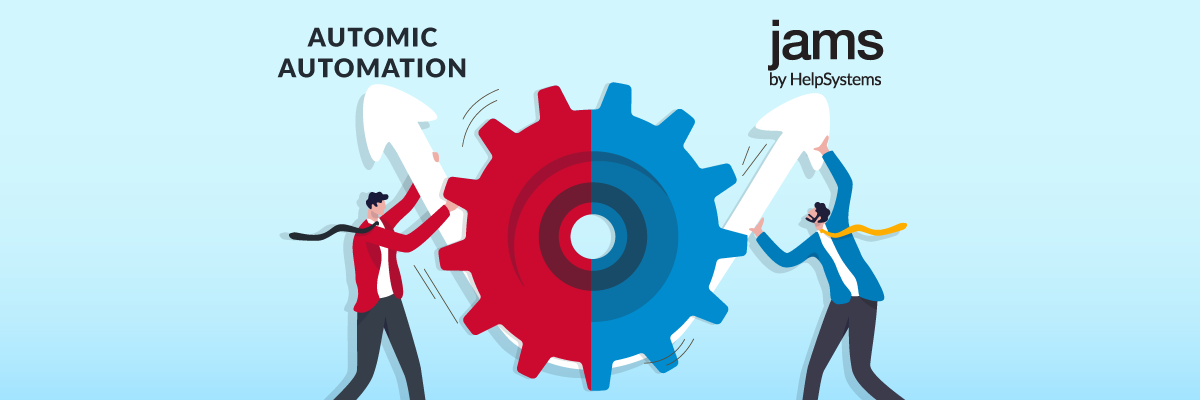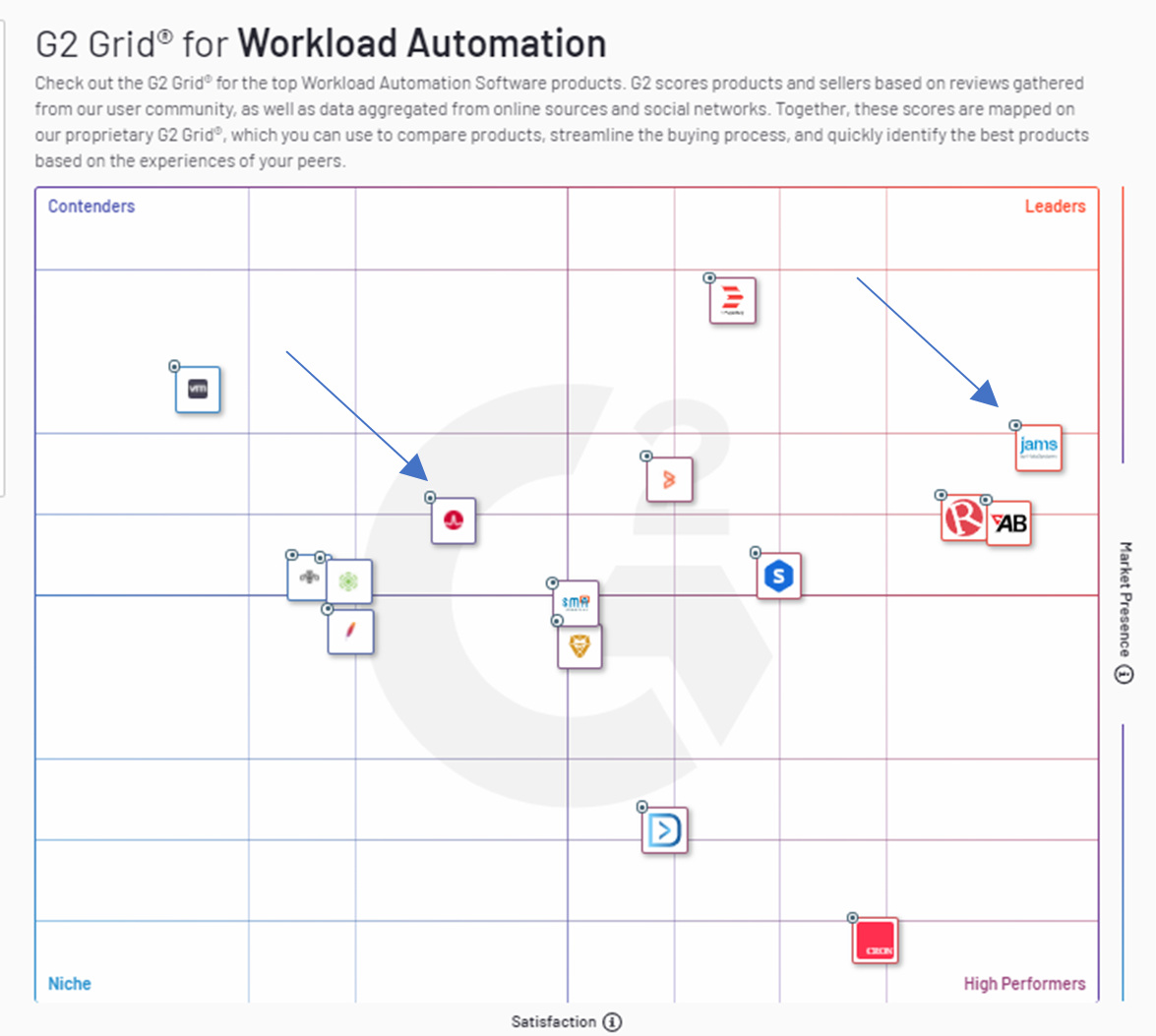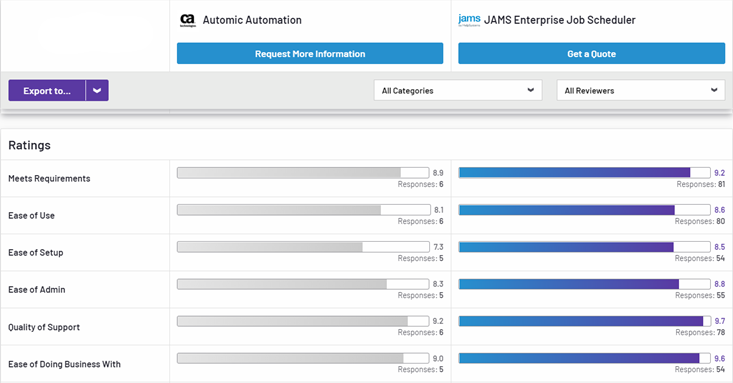Moving Automation Forward: Why Making the Switch from Automic Automation to JAMS Makes Sense

Enterprise workload automation (WLA) is constantly evolving as the needs of organizations continue to shift. Many companies have realized the limitations of their current job scheduler—and are looking for a way to break free from the complexity of their solution. Using a centralized, streamlined workload automation solution can empower the business and take IT automation to the next level.
However, with the considerable investment of time and resources in solutions like Automic Automation, it can seem like an impossible task to switch to another job scheduler. Even so, enterprise workload automation should meet the changing needs of your organization, should be easy to use and administer, and most importantly, should support your automation journey.
Below, we will compare two key solutions within the workload automation space—Automic Automation and JAMS. We will explore how they stack up in terms of meeting requirements, look at how they compare in relation to ease of use, setup, and administration, and examine quality of support based on customer insights and reported experiences. Then, we will provide some practical takeaways to consider when it comes to migrating solutions.
Solution Overviews: Exploring Automic Automation Versus JAMS
JAMS by Fortra and Automic Automation from Broadcom are both key players in the enterprise workload automation space. Let’s quickly look at some defining characteristics of each solution.
Automic Automation Overview
In 1985, the predecessor of Automic Automation was founded as SBB software. Nearly two decades later, in 2004, the brand name was changed to UC4 and quickly became known as a market leader in IT job scheduling. Two years later, Carlyle Group acquired the company, and then in 2012, EQT took over UC4. Finally, in 2013, UC4 was rebranded as Automic.
CA Technologies acquired Automic four years later, but then in November 2018, Broadcom completed acquisition of CA Technologies. Despite changing hands numerous times, Automic Automation is currently ranked very high for its product direction based on user reviews. That’s because Automic offers a unique enterprise solution in the market that provides a single-pane-of-glass across multiple vendors and applications.
Automic Automation also delivers enterprise workload automation solutions with a predictive analytics workload platform that provides companies visualization, adaptability and intelligence to successfully manage complex workloads. Yet based on user experiences, Automic is considered a more complex solution that is difficult to set up and administer.
JAMS Overview
JAMS was originally developed by MVP Systems Software in 1985, and in November 2018, became part of the Fortra family of solutions. JAMS is recognized as a market leader in IT Automation based on user reviews, offering centralized workload automation and job scheduling to run, monitor, and manage jobs and workflows that support critical business processes.
JAMS offers a centralized console to automate across all platforms, APIs, and scripting languages. JAMS offers a future-proofed solution, showing a more detailed evolution of how jobs are built with the full detail of its history down to the code level. Widely considered easy-to-use and set up, JAMS makes it simple to define a stream of jobs that can be managed as a single entity and takes care of sequencing and scheduling individual jobs.
JAMS is well-known in the industry for aggressively updated solutions backed by a top-rated, responsive support and services team. From verifying connection prerequisites, supporting the initial set up of a development environment, or helping explain the client, JAMS ensures customers are supported with the expertise to back it up.
Why JAMS Is a Leading Alternative to Automic Automation: Three Key Differences
When comparing JAMS to Automic Automation, there are several critical distinctions between the solutions. Based on user feedback, JAMS surpasses Automic Automation in terms of meeting requirements, ease of use, setup and administration, and qualify of support.

#1: Meeting Requirements
One critical component of workload automation is ensuring that the solution meets overall business needs and requirements. Based on the G2 Grid for Workload Automation, JAMS significantly outperforms Automic Automation and is known as a Leader in the WLA category, while Automic is ranked lower as part of the Contender Quadrant.
Specifically, JAMS outranks Automic Automation, with an average of 9.2 versus 8.9. Further, users also indicate they prefer doing business with JAMS overall, scoring 9.6 versus 9.0 over Automic.
JAMS offers a superior technical product that better meets business requirements because it is the only job scheduling solution engineered on the .NET framework. The JAMS .NET Class Library exposes each capability of JAMS to applications, providing endless opportunities for automation. All JAMS automation capabilities are accessible to custom applications.
JAMS also enables users to work more efficiently with applications running on the Windows platform with robust automation. And the JAMS REST API provides users with programmatic hooks into jobs and the scheduler. This enables users to create, update, and delete objects within the scheduling environment directly from any applications. Programming interfaces allow for virtually unlimited integrations between JAMS and other technologies used within an environment. With JAMS, organizations can quickly scale their deployment across any system, platform, or application.
“JAMS Scheduler is the only tool that you need for full business automation. What I like best is having only one tool that can automate my entire process for variety of jobs—the process is visible to all.”
– Ahmad G., JAMS User, Large Enterprise
#2: Ease of Use, Setup & Administration

Although the complexity of enterprise IT automation has increased, that does not mean that a WLA solution should be cumbersome to use. Ease of use, setup, and administration are key characteristics that have tangible impact for users. Yet Automic Automation users report that their solution is fairly complex and can be difficult to use. On the other hand, JAMS is ranked by users as a solution that is easier to use, easier to setup, and easier to administer than Automic. According to G2 rankings:
- JAMS outperforms Automic Automation with a score of 8.6 to 8.1 for ease of use
- JAMS outperforms Automic Automation with a score of 8.5 to 7.3 for ease of setup
- JAMS outperforms Automic Automation with a score of 8.8 to 8.3 for ease of administration
This is because JAMS makes it simple to define a stream of jobs that can be managed as a single entity and takes care of sequencing and scheduling individual jobs.
JAMS also evolves workload automation with code-driven, future-proofed centralization. It stores and secures all job definitions into one repository and can execute jobs on any operating system (OS). JAMS can also combine jobs into powerful sequences and provides fair and flexible licensing to organizations seeking to maximize a return on their investment
“JAMS is user friendly, easy to use, and the most feature-rich scheduler I have ever come across.”
– Udaya B., Lead Engineer, Large Enterprise
#3: Quality of Support
Automic Automation has mixed reviews for its customer service, averaging a score of 9.2 from users on G2. JAMS outperforms and out-delivers for customers in terms of overall quality and ongoing customer service and interactions. When assessing the two solutions, reviewers on G2 indicated that JAMS had a better quality of ongoing product support and was the preferred support provider, receiving a 9.7 score overall.
One example of outstanding support offered by JAMS is successful implementations. Experienced consultants work closely with customers to ensure each implementation balances flexibility with performance and security. With expert, highly-ranked implementation services, users count on JAMS for extra guidance and confidence.
JAMS also offers 24/7 support. Whether it’s verifying connection prerequisites, supporting the initial set up of a development environment, or helping explain the client, JAMS ensures customers are truly supported with the expertise to back it up.
“JAMS support is great! The support staff have always assisted with any questions or problems I’ve had. They are friendly and know the product very well. Truly impressed every time I have needed support. Can’t say that about many other companies.”
– JAMS Administrator, Enterprise Retail Organization
Practical Takeaways As You Consider Migrating from Automic Automation to JAMS
With essential business operations at stake, it may seem overwhelming to move from one solution to another. Your experiences with Automic Automation probably make you think there is significant time, cost, and services required to move to a new solution. But migrating from Automic Automation to JAMS is easier, more common, and more predictable than you might think.
One of our primary goals is to minimize the impact on your business and effectively migrate your solution quickly and effortlessly. Using our conversion technologies, we can easily and accurately convert anywhere from a handful of jobs to thousands of jobs. The JAMS conversion utility makes it easy for organizations to migrate batch processes and workflows out of their existing system and into JAMS. Our conversion utility can pull the core properties—schedule, exceptions, credentials, and job source—directly into the scheduler. This process is completed in days—even when countless batch jobs are involved.
If you are considering converting to JAMS, you can be sure that our automation experts have the know-how and experience to streamline your Automic Automation migration. We offer comprehensive solutions and services to assist you—making your migration seamless. Best of all, your organization will have significantly reduced its job scheduling maintenance costs once you have converted to JAMS. We use a proven, repeatable methodology to convert scheduling processes and help you itemize and prioritize the scheduling features you actually use.
